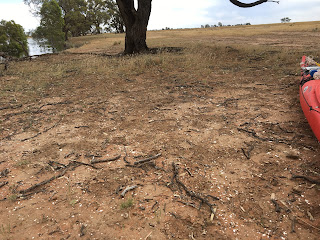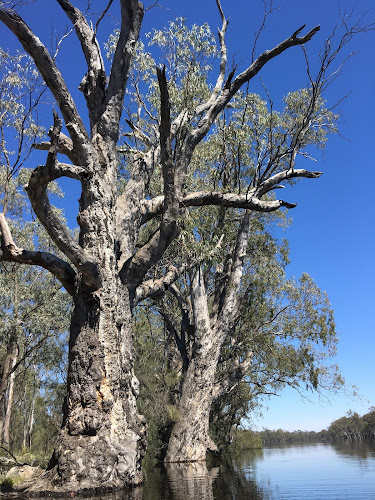784 km Moorna Station 19th Nov 2016
Wentworth Weir - Quiet waters - Blue Sky - The Walsh Family - Flooded landscape
Travelling down a flooded river is an interesting experience. The river is much bigger in all ways. There is more water. it is higher, flowing through the forest wherever it gets a chance; and the currents and swirls they create are stronger too. The quietness of the river, a complete absence of traffic and even people along the banks, adds to the sense of being alone - which makes it feel bigger too. However, it is when you venture into the forest, between the trees, into the flooded billabongs and alongside the reeds that you see the true value of having a high river. When the river is high, it interacts with the landscape. Once in the forest, everything slows down. Often there is hardly any movement discernible in the water. Even air movement drops, which together with the towering gums, creates the most amazing echoes.
In one of our breaks from the main stream, we saw a pink eared duck, in another, how the old course of the river had shaped one of the ancient sand hills. Where the river once flowed is now a billabong, but it is still as wide and majestic as the river itself. The area is peppered with these river remnants. Long after the high river recedes, these places hold water and become important breeding sites for waterbirds, turtles, frogs and all manner of creatures.
We pulled into the Great Darling Anabranch for lunch. The Anabranch is a section where the Darling River splits in two for around 500km. When I last passed this way in 2012, it was little more than a creek. Now it looked like a major river, certainly larger than the Murrumbidgee was where it entered the Murray when I passed it a few weeks ago and with the kind of flow we expected to see in the Darling, before we found out that most of it is being retained in the Menindee Lakes to sure up the water supply of people living in and around Bourke. As we beached our boats, two goannas raced up the trees nearest to them. One of these was right in front of us. It sat there half interested in what we were doing and half concerned the whole time we had lunch. The other goanna was in a tree a bit further back. It was higher, pretending to be part of the bark: both would have been easy catches and a good feed, however we decided to stick to the contents of our tucker bags.
The sky was beautiful today. The river appeared blue too, as its smooth, dark surface reflected the colours above. Clouds moved through, changing shape and patterns. My need to take photos every 250m prompting me to look at them. They are so often ignored. We tend to look at our level, ignoring what is going on above us. The skies can be magnificent, and not just at sunset.
Around 4:30pm we arrived at Moorna station and waited on the porch overlooking the river for the family to return home. Moorna is a grand house, with high ceilings which hold the heat of the day at bay. From the porch there was an excellent view of the river. Moorna is set high above the water on the edge of one of the high sand dunes typical of the area. A well kept lawn bordered by rosemary and flowering plants runs down to a traditional country fence and a set of broad steps down to the river. Moorna was built before the Cobb and Co coach established its Mail run, when there were only bullock tracks and bush. How exciting must it have been to see the paddle steamers come up the river with supplies and company, and for the captains, or their guests to spend time in this outpost of western civilisation?
Moorna is run by Annabel Walsh. Her family views themselves as custodians of the land. They pioneered the use of fences which allow wildlife to pass, but not stock and are champions of the use of native perennials on farms, especially native grasses. Annabel is one of the driving forces behind 'Stipa', the Australian native grasses association. Native grasses make farms more drought resistant, because of their deep roots and adaptations to local environments. It was plains full of native grasses that led explorer Thomas Mitchell to declare the inland 'Australia Felix'. Paddle steamers provided the means of getting wool to the ports of Melbourne and Adelaide on a scale which brought prosperity to those early settlers. Moorna heralds from those times. Since then, Moorna has handed over most of the river frontage, which runs all the way to lock 8 to National Parks. Today this riparian landscape is managed by an aboriginal cooperative. Whilst she is glad to see that long association with the land continued, the bureaucratic processes involved have led to the fences becoming run down and the native grasses they planted being eaten out by an overpopulation of kangaroos. Annabel believes that local indigenous people still have the knowledge within them to manage the land back to health, and that she could provide them with tools and strategies, but is hindered by the complicated and distanced nature of management. She says that to improve the river, you need to look after its connection with the landscape. By planting native grasses, much of the organic material which is causing the current black water event can be assimilated into the soil, their roots anchor the soil and their tufted growth slows down river currents, protecting the banks. After the recent heavy rains that led up to this high river, the Murray ran red, the colour of the sandhills. Australia needs more people like Annabel Walsh and her family, and to respect and incorporate local expertise into the way we manage our river landscapes.
This has been one of the most diverse, resilient and impressive sections of the river so far. At low river, the beaches are river gold. Now, at high river, the focus is on the trees: no less impressive and with a longer story. The banks too, give hints about the changes that have happened in the past. The river was not always this shape, or ran where it does now. Its story is older than our habitation of this land, of anyone’s habitation, however it is what makes it all possible. For all of our sakes, it needs to be looked after.



























































